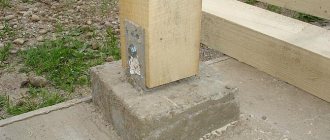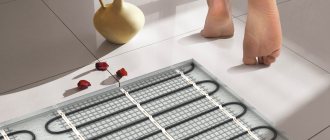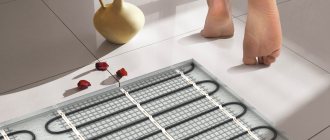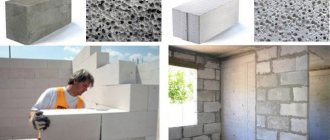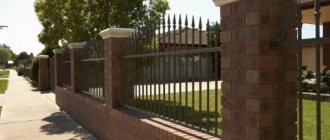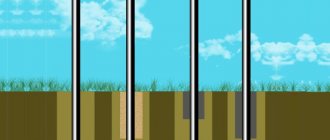All considerations of options for how to install a wooden pole may turn out to be correct depending on the purpose and material of the poles. Temporary fencing, garden fence, light mesh fence, each option may have its own correct solution. Perhaps the correct one would be not a wooden pole, but a concrete or metal one. See my personal solution at the end.
It is worth saying that a wooden post or beam means a post/beam made of pine.
By wooden post or beam we mean a post/beam made of pine.
kind of disclaimer...
It is worth remembering that correct installation depends on the purpose of the pole, expected service life and climatic conditions. This post should be considered in conjunction with the post Processing and installation depth of a wooden pole.
Based on these conditions, the applicability of the following options for installing wooden fence posts or supports can be assessed:
- With backfilling of native soil (installation in the ground);
- Backfilled with crushed stone;
- Installation in concrete;
- Concreting using a metal sleeve;
If your goal is to choose a technology for installing fence posts, then at the end of the post pay attention to the option of using reinforced concrete posts, a very competitive option in all respects.
The purpose of this post is not to replace the requirements or recommendations of SP and SNiP, but to show possible options for use on a personal plot.
How to ensure waterproofing of a pole and choose the correct installation depth for a wooden pole can be read here: Processing and installation depth of a wooden pole.
Wood selection
When installing posts, pay attention to the type of wood used in construction. Soft rocks react poorly to moisture, which is abundant in the soil: they quickly rot, become moldy, and collapse.
Important! Solid wood (oak, beech) is best suited for this purpose, but it has a significant drawback - its high price.
Wooden fence posts
To reduce costs, choose a more affordable material, for example, pine wood. It is quite dense, not subject to putrefactive processes, does not crack after drying, and does not suffer from deformation.
How to build a wicker fence from boards with your own hands - Construction
The fence is the face of any site; it is visible to everyone passing by. Therefore, choosing a fence design is not an easy task.
You want it to be beautiful and durable, but at the same time you don’t need to put in a lot of effort during construction, and cost is also important. An interesting and infrequently used option would be a wicker fence made from boards.
Previously, such fences were made of wicker and used for decorative purposes, but now a wicker fence is a complete protection of the site.
Advantages and disadvantages of wooden “wicker”
According to the technology of execution, such a fence is similar to an ordinary wattle fence - the oldest invention of mankind. It is made from planed boards that can be placed vertically and horizontally. The last option is more common.
A wicker fence will decorate any home or property
Pros:
- easy and quick to install, even a non-professional can do it;
- the building is environmentally friendly, the fence breathes, allows air and even light to pass through;
- at the same time, the dacha plot is well closed from prying eyes;
- the fence looks original and stylish, you can change the bend pattern;
- materials for production are inexpensive.
Minuses:
- short service life - no more than 10 years;
- when the wood dries, the boards bend;
- the difficulty of secondary and subsequent processing of boards: in order to paint them, you will need to disassemble the structure or use a spray gun. Planed fence boards must be painted regularly to extend its service life
Types of wicker fences made of planed boards
There can be many options for such a fence, but they are all divided into two groups:
- with vertical arrangement of boards;
- with horizontal weaving.
Fences with different arrangement of boards in the photo
Thanks to the light color, a fence with vertically interwoven boards does not look heavy. Why not make a fence with both vertical and horizontal weaving at the same time - it looks very original. The thicker the fence posts, the greater the bend of the boards and the more carefully you need to mount the fence so as not to break it boards Wicker fence - ideal for a multi-level area
Tree protection
To extend the service life of the finished wooden structure, it is necessary to use additional protective equipment. This applies to any type of wood, even the most durable.
In order to reduce the rate of destruction under the influence of the sun, wind, precipitation, and temperature changes, the following measures are carried out:
- For the aboveground part of the pillars. The surface is sanded until smooth and allowed to dry thoroughly. Afterwards, a wood varnish with moisture-proof properties and frost resistance is applied.
- For the underground part of the pillars. Impregnate the wood with bitumen mastic or another bitumen-based composition, twice (with a difference of a day). Instead, you can use rolled waterproofing, wrapping the posts at the bottom, or walk over them with open fire (brushing).
Impregnation of pillars with bitumen mastic
Structural features of a frame house
The walls, floors and roof of a frame house bear the main load.
The framing of a frame house is the connecting element of a building on a columnar or pile foundation. The lower nodes provide the connection between the parts of the base structure between the posts and the walls. The strapping along the top acts as a unifying system for the partitions, and also distributes the load from the roof.
There are two categories of components of frame wooden houses.
Main nodes:
- wall system;
- ceilings (ceilings and floors);
- roofing system.
Auxiliary nodes:
- connections of various parts;
- fastenings and places of joining of jumpers.
For some types of buildings, piping is not necessary. For example, if the building has a small area and the height of the piles from the ground is less than 0.5 m. Piping is optional when the house is built on a monolithic strip foundation. But if the building has 2 or more floors, as well as a complex structure, connecting elements must be present.
Buy boards and timber from coniferous trees, as they have optimal performance characteristics.
How to install poles
Before pouring the concrete solution, prepare holes for the posts. Typically, each of them is buried in the ground by a third of its total length.
Important! The depth of the holes will depend on both the level of groundwater and the freezing of the soil. In any case, it should be greater than these indicators.
Rubble cushions are placed at the bottom of the pits. It will serve as drainage and prevent water from accumulating in one place. The thickness of the crushed stone layer is 15-20 cm.
Pole installation diagram
Separately, prepare a mixture from soil extracted from pits, crushed stone, and broken bricks. A post is inserted into each hole, covered with soil and fillers, and compacted well. There should be about 20 cm left to the top soil level - concrete is poured here.
Reinforcement
To ensure that the posts are securely held inside the pits, they are additionally reinforced with metal rods. The latter are installed directly into the cushion, onto which the concrete solution is then poured.
The reinforcement bar is placed so that it rises 20-25 cm. A hole is drilled in the bottom of the wooden post according to the diameter of the bar, which is wrapped with waterproofing material. This reinforcement method can be used not only when constructing fences, but also when installing any structures with a strip foundation.
Types and sizes:
The classic beam (beam) support is a U-shaped bracket made of thick metal with a support platform for the beam and perforated sidewalls. The fastening tabs on the sides can be bent outward ( open type
) or bent inward (
closed type
). The latter are used when installing beams in corner places where it is not possible to install an open support.
The size of the support fasteners is selected in accordance with the cross-section of the beam. Standard supports have a width of 25 – 150 mm, a height of 95 – 170 mm (closed), 90 – 200 mm (open).
There are also universal separate beam supports - left
and
right
. They consist of two halves and are used in pairs. Available in one standard size: 25 x 140 mm. Their advantage is that they are not tied to the size of the beam, so they are suitable for any and even non-standard beam sections.
Special method of fastening poles
There is an interesting method of fixing wooden posts on a concrete base - using so-called monolith stepsons. Small posts (stepchildren) are made from concrete mortar in advance, to which wooden posts are then tied.
The stages of work will be as follows:
- applying bitumen waterproofing to wooden supports;
- treating excavations in the ground with bitumen (or laying a membrane);
- backfilling of small crushed stone, installation of stepsons and compaction;
- fixing the stepsons with small spacers;
- backfilling pits with soil mixed with sand, crushed stone, broken bricks, tamping (there should be holes 15-20 cm deep);
- pouring concrete mortar;
- keeping the concrete until completely hardened;
- fastening wooden posts to concrete steps with wire.
Installation on concrete steps
Fence fasteners
The construction of a fence around the perimeter of the site requires strict adherence to construction regulations at all stages of work. The slightest deviation from established standards can cause deformation of the fence. Before you start building a fence, for example, from corrugated board, you should know exactly how to install the posts, how to fasten the corrugated sheet, what fixing products to use (screws, bracket, clamp, rivets).
This is what self-tapping screws with rubber washers look like for screwing corrugated sheeting to the fence frame
Fastening fence logs made of lightweight building materials, for example, corrugated sheets, picket fences or wooden boards, must be done only with the use of high-quality components. In former times, fence logs made of corrugated sheets were attached to the supporting screw piles by welding. Such work could only be done by professionals and required the presence of electricity and welding equipment on site. Fences made by welding did not always look like an example of aesthetics and required constant anti-corrosion treatments at the attachment points.
Modern fences for personal plots are mainly modular fences made without welding, which are easy to assemble, original and durable. They are kits consisting of supports, sections and fasteners.
Option for attaching cross beams to fence posts
Fasteners for such fences also correspond to modern trends. In most cases, metal frames are held together using devices such as a clamp or bracket.
In recent years, the well-proven x-fastener for fences has become very popular, providing a fast, aesthetic and high-quality connection. Any fastener for corrugated sheets or other sectional fabric is a product specifically designed for construction work. Fastening corrugated sheet logs using modern fixing methods is possible even for beginners.
Fasteners for corrugated sheeting on the fence are made of high-quality steel coated with anti-corrosion powder or zinc. Various fasteners and additional components are provided for logs, posts and fence panels, for example, rivets, a clamp or a suitable bracket.
An example of various types of clamps for attaching corrugated sheets to a pole
You can buy these accessories at any specialized market, in online stores or in construction goods supermarkets.
Types of fastening
Fence fasteners for corrugated sheets are presented in two main types:
- Bracket or x-bracket;
- Fasteners for joists and posts.
The clamp, bracket or rivets are designed for different types of fixation. Their correct combination will help to firmly connect the pillars and horizontal veins (joists). Anyone can buy these parts, and their ease of use does not require any experience or the use of special devices and apparatus.
Drawing of possible options for attaching the log to the pole
Thanks to products such as fasteners for corrugated sheets, polycarbonate, picket fences or wood, the construction of fences of any complexity is greatly facilitated.
Manufacturing of fasteners and their advantages
Fasteners for corrugated sheets, for example, a bracket, are made by stamping from a hot sheet of metal. The fastening clamp, with which the pillars are connected to the joists, is made from bent metal parts welded to each other.
The finished bracket is subjected to hot-dip galvanizing, and the welded fasteners are painted with protective powder paints.
These accessories provide the fence with aesthetics, good wear resistance and strong fixation for the entire service life. Attaching corrugated sheeting to a fence using fasteners is becoming an increasingly popular way to connect structures.
Scheme of correct fastening of a corrugated sheet to the frame
The advantages of using this fixation method include the following:
- Convenience and ease of connection;
- Availability;
- Fast pace of installation;
- All joining points look beautiful and neat;
- There is no need for electricity and welding machines;
- The integrity of the top layer of mounted structures is maintained.
Special fasteners for corrugated sheets, such as a clamp, help connect posts, crossbars and fence sections firmly and efficiently. At the same time, the elements of the fence are not subjected to rough impact and mechanical damage.
This connection gives the fence external beauty, integrity and ensures its long service life. If you need to rearrange the pillars, change the fastening of the joists, or dismantle the fence, then this can be done without damaging the prefabricated components.
Profiled sheet
Most often, fences made of corrugated sheets are erected around dacha and land plots. This material is versatile, strong, affordable and durable. The corrugated sheet is used as a fence covering throughout. Even a novice builder can easily learn to work with it. A wide range of colors and an assortment of profiled sheets adds to its popularity. You can buy a quality product in many stores across the country at a relatively low price.
The material consists of a sheet of steel that has been galvanized and treated with anti-corrosion treatment. A primer is applied over the protective layers. The last coating of the product - the corrugated fence is covered with paint with polymer components. To prevent the canvas from being damaged during the construction of the fence, only special fasteners, such as a clamp or brackets, must be used to secure it.
How else can you secure the pillars?
Another effective method of fixing a wooden support in concrete is installation in a box. It is suitable if there is already a poured concrete surface on top of which you need to install pillars. A box is attached to the concrete on top - a metal product with holes for fasteners. A post is placed inside the box, and then screwed to the concrete with dowels.
In addition, you can attach wooden supports to concrete with specially made fasteners. It is bent from reinforcement with an attached U-shaped retainer with holes.
Before pouring concrete, the structure is placed on the site, and after hardening, the pillar is fixed using bolts and self-tapping screws. Any of the presented methods of attaching wooden supports to a concrete surface is reliable and makes it possible to build a durable structure with your own hands.
General information
The need to install wooden poles on concrete can arise in a variety of situations, for example, when installing fences, building gazebos and other wooden structures on a strip foundation.
At first glance, it may seem that installing a wooden pole on concrete is very difficult, but in reality, professionals have some tricks that allow them to cope with this operation without any difficulties. Below you can see for yourself.
